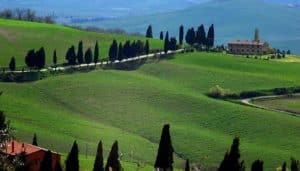The Via Francigena
 Which is translated as “the road that comes from France,” is one of the three big Christian pilgrimages together with the Spanish Camino de Santiago and the less well-known pilgrimage from Rome to Jerusalem.
Which is translated as “the road that comes from France,” is one of the three big Christian pilgrimages together with the Spanish Camino de Santiago and the less well-known pilgrimage from Rome to Jerusalem.
This ancient road commences at Canterbury Cathedral in southern England and progresses through Kent, the battlefields of the region of northern France, the peaks of the Swiss Alps, down into the Aosta Valley of Italy and onto Tuscany and Lazio before ending at St Peter’s Basilica in Rome.
There is no single path by which the pilgrims traveled from Canterbury to the Terra Santa or the tomb of St. Peter and Paul in Rome. In reality, the Via Francigena was an uncodified path that pulled several different roads that the pilgrims walked as they entered Italy from areas throughout Europe. In fact, it wasn’t until the 1980s that Italian researchers came across the journal of an abbot names Sigerico, who was the Bishop of Canterbury in 990, and were able to finally identify a real route. Sigerico is widely believed to be the first person to complete the pilgrimage and, in his journal, he described 80 different stops between Rome and Canterbury, 15 of which were in Tuscany, covering a total 1,700 kilometers and around 20 kilometers a day. Unlike the ancient Roman roads, which connected cities, the Via Francigena connected abbeys and important Christian places of worship along the road to Rome. As more and more people took up the pilgrimage, it became an important route that was lined with trade posts and, as such, made a significant contribution to the rebirth of European commerce.
Today, people continue to travel the Via Francigena

Be it on foot, horseback or bike. There are many areas of interest along the path, from spectacular landscapes and natural features through to artistic wonders and architectural treasures. It has become a great example of slow travel, via which pilgrims can enjoy great hospitality and affordable accommodation. It has also been awarded UNESCO World Heritage Site recognition, and significant effort has been invested in ensuring that developments along the route are environmentally sustainable.
The Tuscan section of the Via Francigena commences at the Cisa Pass in Pontremoli, from where it follows a mule track to the Pieve di Sorano in Filattiera before continuing to Aulla, Massa and Pietrasanta, and Camaiore in Versilia, along one side of the Apuan Alps. It then passes through Lucca, where pilgrims stop at the magnificent cathedral. From there, those who tread the Via Francigena will progress to Altopascio, Porcari, and Fucecchio, before crossing the Arno River and visiting San Miniato. The path then leads to the Val d’Elsa road, over the vineyard-covered hilltops through olive-tree lined paths and cultivated farmland. Pilgrims travel onwards through San Gimignano, Monteriggioni, stunning Siena, the bright roads of the Val d’Arbia and the ancient hill town of Buonconvento. In Val d’Orcia, pilgrims also encounter the fortified medieval villages of San Quirico, Bagno Vignoni, and Radicofani.
Read About Typical Desserts In Tuscany
Read About Carnival In Viareggio
Visit the home

